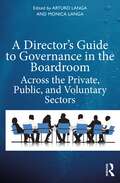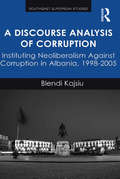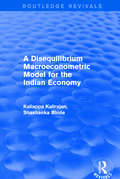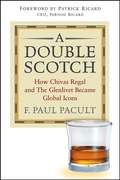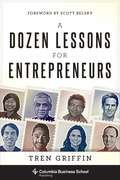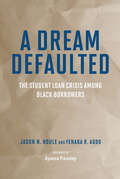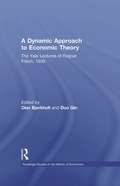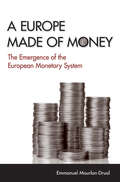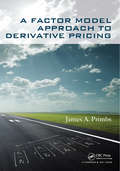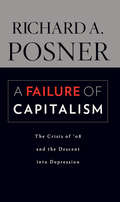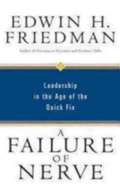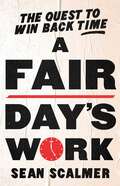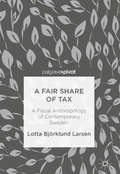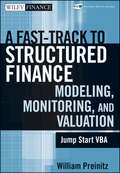- Table View
- List View
A Director's Guide to Governance in the Boardroom: Across the Private, Public, and Voluntary Sectors
by Arturo LangaThis book is a practical guide for executive and non-executive directors and aspiring directors to lead, govern, and steer UK-based organisations to long-term sustainable success. In today’s turbulent environment, corporate governance is increasingly scrutinised, and this book will consider how directors can ‘bring the future forward’ with respect to responsible and ethical governance and leadership against the challenging political, environmental, and economic backdrop. While other books discuss UK corporate governance, this one uniquely demonstrates how the work of directors can build an organisation’s antifragility, and offers a view of stewardship approaches to every sector and type of UK organisation, from large premium listed companies to start-ups, the public sector, not-for-profits, partnerships, and family-owned and private-equity-backed organisations. Aspiring and experienced directors will each benefit from this book as well as those who provide board evaluation services, professional advisers, auditors, and those who provide training and other support for board members.
A Discourse Analysis of Corruption: Instituting Neoliberalism Against Corruption in Albania, 1998-2005 (Southeast European Studies)
by Blendi KajsiuWhy did Albania enjoy some of the most successful anti-corruption programs and institutions along with what appeared to be growing levels of corruption during the period 1998-2005? Looking at corruption through a post-structuralist discourse analysis perspective this book argues that the dominant corruption discourse in Albania served primarily to institute the neoliberal order rather than eliminate corruption. It did so in four interrelated ways. First, blaming every Albanian failure on corruption avoided a critical engagement with the existing neoliberal developmental model. Second, the dominant articulation of corruption as abuse of public office for private gain consigned it to the public sector, transforming neoliberal policies of privatisation and expanding markets into anticorruption measures. Third, international anticorruption campaigns reproduced an asymmetric relationship of dependency between Albania and the international institutions that monitored it by articulating corruption as internal to the Albanian condition. Finally, against corruption international and local actors could articulate a neoliberal order that was free of internal contradictions and fully compatible with democratization. As a rare example of post-structuralist discourse analysis of corruption this book can be useful for future research on discourses of corruption in other countries of the region and beyond.
A Disequilibrium Macroeconometric Model for the Indian Economy
by Kaliappa Kalirajan Shashanka BhideThis title was first published in 2003. This text presents a new approach to incorporating regional details on production in a disequilibrium macroeconometric model. The early studies on disequilibrium dealt with either partial-adjustment models or models involving excess demand or supplies in markets. In this study the authors consider a different type of disequilibrium model - one in which econometric analysis makes use of the varying coefficients stochastic production frontier approach, which permits estimation and analysis of production efficiencies of individual producers. The book also presents an innovative approach to production modelling in macro econometric models as it provides a useful framework for incorporating production efficiencies and regional details of production in the macro models. It is a pioneering study that combines the stochastic frontier approach with macro econometric modelling. Primarily focused on India, it also provides insights into problems in modelling economies of other developing countries.
A Disposition to Be Rich
by Geoffrey C. WardFerdinand Ward was the greatest swindler of the Gilded Age. Through his unapologetic villainy, he bankrupted Ulysses S. Grant and ran roughshod over the entire world of finance. Now, his compelling, behind-the-scenes story is told--told by his great-grandson, award-winning historian Geoffrey C. Ward.Ward was the Bernie Madoff of his day, a supposed genius at making big money fast on Wall Street who turned out to have been running a giant pyramid scheme--one that ultimately collapsed in one of the greatest financial scandals in American history. The son of a Protestant missionary and small-town pastor with secrets of his own to keep, Ward came to New York at twenty-one and in less than a decade, armed with charm, energy, and a total lack of conscience, made himself the business partner of the former president of the United States and was widely hailed as the "Young Napoleon of Finance." In truth, he turned out to be a complete fraud, his entire life marked by dishonesty, cowardice, and contempt for anything but his own interests.Drawing from thousands of family documents never before examined, Geoffrey C. Ward traces his great-grandfather's rapid rise to riches and fame and his even more dizzying fall from grace. There are mistresses and mansions along the way; fast horses and crooked bankers and corrupt New York officials; courtroom confrontations and six years in Sing Sing; and Ferdinand's desperate scheme to kidnap his own son to get his hands on the estate his late wife had left the boy. Here is a great story about a classic American con artist, told with boundless charm and dry wit by one of our finest historians.
A Dose of Positivity: Tools, Techniques, and Strategies to Live Life on Your Terms
by Mike DiamondLife coach and television personality Mike Diamond explains his tried-and-true methods for empowerment and offers tools and stories to help you find your purpose and create your ideal future. Mike Diamond got off to a bit of a rough start in life—battling undiagnosed dyslexia, exposure to drugs and alcohol at age 12, and struggling to finish high school. A stroke of luck, however, earned him a Green Card in 1997, and he moved to the States, where he landed acting roles and built a career in entertainment, appearing on Miami Ink and NY Ink, and later directing, producing, and starring in Bondi Ink Tattoo Crew. Despite this initial stream of success, however, Mike found himself spiritually bankrupt and thoroughly miserable. Realizing his life depended on it, in 2006 Mike decided to get sober and, with his life completely turned around, has now helped hundreds of people on their own paths to recovery. In A Dose of Positivity, Mike shares not only his own incredible stories of overcoming hardship, but also reveals his personally tested techniques for staying grounded, finding success, and creating positive change. This book provides concrete tips on how to lean on and trust your Source—the spiritual energy and intuition within you—to maintain the flexible attitude necessary for your success. No matter what obstacles you face, a properly cultivated mindset can make all the difference. With A Dose of Positivity, unlock your potential and discover how to make your dreams a reality—with guidance from someone who&’s personally tested everything he recommends.
A Double Scotch
by Pacult F. PaulA Double Scotch tells the intertwined success stories of Chivas Regal and The Glenlivet-two Scotch whisky brands recognized the world-over for their unparalleled quality. Founded by Scottish grocers from Aberdeen, Chivas Regal stands as the world's most popular prestige blended Scotch. First distilled by a pistol-packing Highlander, The Glenlivet is today the top-selling single-malt Scotch in America. F. Paul Pacult explores these two iconic spirits and tells the remarkable story of the two families who endured numerous hardships to build their brands. A business book that goes down easy, A Double Scotch tells the story of the world's favorite whiskies, and the story of the nation and families that made them so.
A Dozen Lessons for Entrepreneurs (Columbia Business School Publishing Ser.)
by Tren GriffinA Dozen Lessons for Entrepreneurs shows how the insights of leading venture capitalists can teach readers to create a unique approach to building a successful business. Through profiles and interviews of figures such as Bill Gurley of Benchmark Capital, Marc Andreesen and Ben Horowitz of Andreesen Horowitz, and Jenny Lee of GGV Capital, Tren Griffin draws out the fundamental lessons from their ideas and experiences. Entrepreneurs should learn from past successes but also be prepared to break new ground. While there are best practices, there is no single recipe they should follow. By better understanding the views and experiences of a wide range of successful venture capitalists and entrepreneurs, readers can discern which of many possible paths will lead to success.With insight and verve, Griffin argues that innovation and best practices are discovered by the experimentation of entrepreneurs as they establish the evolutionary fitness of their business. The products and services created through this experimentation that have greater fitness survive, and less-fit products and services die. Entrepreneurs have always experimented when creating or altering a business. What is different today is the existence of modern tools and systems that allow experiments to be conducted more cheaply and rapidly than ever before. Griffin shows that listening to what the best venture capitalists have to say is invaluable for entrepreneurs. Their experiences, if studied carefully, teach bedrock methods and guiding principles for approaching business.
A Dream Defaulted: The Student Loan Crisis Among Black Borrowers
by Jason N. Houle Fenaba R. AddoA Dream Defaulted explores how the student loan crisis disproportionately affects Black borrowers and why rising student debt is both a cause and consequence of social inequality in the United States.Jason N. Houle and Fenaba R. Addo offer a deft analysis of the growing financial crisis in education, examining its sources and its impacts. Based on more than five years of ongoing qualitative and quantitative research, this incisive work illustrates how the student loan system has not benefited all students equally. The authors tell the story of how first-generation college students, low-income students, and students of color are disadvantaged in two opposing phases of the process: debt accumulation and debt repayment. They further demonstrate that policies intended to mitigate financial burden and prevent default have failed to assist the people who most need help.Houle and Addo present these social and racial disparities within a broader context, tracing how centuries of institutionalized racism have contributed to social and economic inequities, perpetuating the racial wealth gap and leading to intergenerational inequality. Through interviews with borrowers, they illuminate the ways in which racial disparities affect who has college access, how and why people take on debt, and who has the ability to repay student loan debt after leaving college.Recognizing that the affordability crisis cannot be solved by higher education reform alone, Houle and Addo consider solutions. They argue that policy must extend beyond debt reduction and financial aid to address entrenched patterns of racial inequality and racial discrimination, both inside and outside institutions of higher education.
A Dream Foreclosed
by Clarence Lusane Laura GottesdienerTold through the eyes of four homeowners-a grandmother in Detroit, an entrepreneur in rural North Carolina, a man in Chattanooga, and a mother in Chicago-A Dream Foreclosed presents a people's history of the U.S. financial crisis and the rise of a people's movement for economic justice, dignity, and freedom from foreclosure. With power and humanity, Laura Gottesdiener bears witness to the ordinary people organizing their communities to challenge the banks and legal system. Their stories are extraordinary but the situation is all too common.The ongoing mortgage crisis has created one of the longest and largest mass displacements in U.S history. While profiting from government bailouts, banks have evicted more than ten million Americans from their homes, their life savings, and their dreams. As many of the families victimized by bank fraud, predatory loans and other corporate crimes are African American, communities of color have been among the most outspoken and organized in confronting the banks.Woven throughout Gottesdiener's page-turning narrative are clear explanations of the origins of the crisis, the consequences for housing, and how community organizing and social movements are having national impact.PRAISE FOR LAURA GOTTESDIENER ANDA DREAM FORECLOSEDAlice Walker, Pulitzer Prize-winning author of The Color Purple"I'm spreading the word about Laura Gottesdiener's FINE book wherever I go and wherever I am. [It's] a wonderful book."Naomi Klein, author of The Shock Doctrine"A riveting book."Ralph NaderLaura Gottesdiener has the acute eye and pen of a young progressive star with extraordinary talent. Her pages should grip you with motivational indignation."Johanna Fernandez professor in the Department of History at Baruch College "From the time of their capture in Africa, through Emancipation and the Great Migration, to the national economic and housing crisis of today, people of African descent in the United States have been defined by their search for home. Using the dreams and aspirations of four families as her point of departure, Laura Gottesdiener narrates a beautifully crafted story about predatory lending, foreclosure abuse, the racial politics of home ownership, and the brave struggles launched by African American communities to keep their dignities and their homes. ... a powerful, impressive and page-turning testimony that ordinary people can fight back and win."Noam Chomsky"The legislation to rescue the perpetrators of the current financial crisis included provisions for limited compensation to their victims...the enormity of the crime strikes home vividly in the heart-rending accounts of those who are brutally thrown out of their modest homes - for African Americans particularly, almost all they have - then survive in the streets, struggle on, and sometimes even regain something of what was stolen from them thanks to the courageous and inspiring work of the home liberation activists, now reinforced by the Occupy movement. All recounted with historical depth and analytic insight."Tim Wise "A brilliant and needed narrative by an insightful and inspiring author."Clarence Lusane, author of The Black History of the White House "[a] brilliant discourse on the battle over home and community by African Americans... [w]e owe Gottesdiener a great debt for her research and powerful argument that permeates A Dream Foreclosed. ... She takes sides in this battle and gives voice to those who are rarely if ever heard."Mumia Abu-Jamal , Counterpunch"A Dream Foreclosed finds beauty amidst immense pain and suffering-the beauty of people continuing to fight back against rapacious banks, the politicians they buy and the lawyers they hire. It is a work both beautiful and terrible that deserves to be read by many."Marc Lamont Hill, Huffington Post Live"An incredible book...a great set of stories being told here...and more importantly, a powerful narrative about the relationship between black people and ownership"
A Dynamic Approach to Economic Theory: The Yale Lectures of Ragnar Frisch
by Ragnar FrischThis book contains a set of notes prepared by Ragnar Frisch for a lecture series that he delivered at Yale University in 1930. The lecture notes provide not only a valuable source document for the history of econometrics, but also a more systematic introduction to some of Frisch’s key methodological ideas than his other works so far published in various media for the econometrics community. In particular, these notes contain a number of prescient ideas precursory to some of the most important notions developed in econometrics during the 1970s and 1980s More remarkably, Frisch demonstrated a deep understanding of what econometric or statistical analysis could achieve under the situation where there lacked known correct theoretical models. This volume has been rigorously edited and comes with an introductory essay from Olav Bjerkholt and Duo Qin placing the notes in their historical context.
A Dynamic Model of the US Energy System: A Tool For Energy R & D Planning (Routledge Library Editions: Energy Economics)
by John P. WeyantOriginally published in 1984, this book develops a quantitative model designed for use in the evaluation of the relative merits of alternative energy R&D programmes. It is used to compare the merits of major energy-technology R&D programmes during the 1970s in the USA: Liquid-metal fast breeder reactors, synthetic fuels derived from coal and oil shale and improved efficiency in end-use technologies. The benefits/disadvantages are analyzed in terms of economics, security and the environment. Although published some years ago, the economic benefit assessed is in terms of the impact that commercialization of a particular energy-technology would have on the total 60 year cost of the US energy supply system. The security benefit is measured in terms of the reduction of crude oil imports and the environmental factors are measured here by the total tonnage of coal and oil shale that is extracted each year. All of these issues continue to be relevant today.
A Empresa Regenerativa
by Patrícia Pinto Ethan Roland Gregory LanduaAs 8 Formas de Capital: Um novo modelo financeiro em prol de uma abundância otimizada Num mundo de sistemas ecológicos e sociais danificados, com uma economia global fragilizada e com as constantes alterações climáticas, o negócio tal como o conhecemos, poderá desenvolver-se, mas também pode correr o risco de não conseguir sobreviver. Nada é mais aceitável do que alcançar os lucros financeiros, extrair proveitos abundantes e proporcionar uma boa prosperidade que é fundamental aos nossos terrenos e fontes de água. As empresas precisam de um novo modelo com o qual possam abordar, de uma forma mais abrangente, o mundo e dar importância à necessidade da introdução de um processo novo no sistema enquanto se elucidam as pessoas nas tomadas de decisão mais relevantes. As 8 Formas de Capital é o modelo a seguir. Ao articularmos estas formas múltiplas de capital nas transações diárias, estamos a abrir portas a uma realidade mais abrangente sobre os lucros e sobre a economia. A Empresa Regenerativa define a diferença existente entre os sistemas degenerativos, os sustentáveis e os regenerativos. Também articula os quatro fatores da empresa regenerativa e os princípios para a concepção de empresa ecológica regenerativa. O Instituto "Regenerative Enterprise Institute", ou o seu representante em Portugal, também oferece serviços de formação e consultoria às empresas e corporações que querem adaptar-se e aderir à resolução dos sistemas regenerativos.
A Europe made of money: the emergence of the European Monetary System
by Emmanuel Mourlon-DruolA Europe Made of Money is a new history of the making of the European Monetary System (EMS), based on extensive archive research. Emmanuel Mourlon-Druol highlights two long-term processes in the monetary and economic negotiations in the decade leading up to the founding of the EMS in 1979. The first is a transnational learning process involving a powerful, networked European monetary elite that shaped a habit of cooperation among technocrats. The second stresses the importance of the European Council, which held regular meetings between heads of government beginning in 1974, giving EEC legitimacy to monetary initiatives that had previously involved semisecret and bilateral negotiations. The interaction of these two features changed the EMS from a fairly trivial piece of administrative business to a tremendously important political agreement.The inception of the EMS was greeted as one of the landmark achievements of regional cooperation, a major leap forward in the creation of a unified Europe. Yet Mourlon-Druol's account stresses that the EMS is much more than a success story of financial cooperation. The technical suggestions made by its architects reveal how state elites conceptualized the larger project of integration. And their monetary policy became a marker for the conception of European identity. The unveiling of the EMS, Mourlon-Druol concludes, represented the convergence of material interests and symbolic, identity-based concerns.
A European Mandate for Financial Sector Supervisors in the EU
by Daniel C. HardyA report from the International Monetary Fund.
A Fabric of Defeat
by Bryant SimonIn this book, Bryant Simon brings to life the politics of white South Carolina millhands during the first half of the twentieth century. His revealing and moving account explores how this group of southern laborers thought about and participated in politics and public power. Taking a broad view of politics, Simon looks at laborers as they engaged in political activity in many venues--at the polling station, on front porches, and on the shop floor--and examines their political involvement at the local, state, and national levels. He describes the campaign styles and rhetoric of such politicians as Coleman Blease and Olin Johnston (himself a former millhand), who eagerly sought the workers' votes. He draws a detailed picture of mill workers casting ballots, carrying placards, marching on the state capital, writing to lawmakers, and picketing factories. These millhands' politics reflected their public and private thoughts about whiteness and blackness,war and the New Deal, democracy and justice, gender and sexuality, class relations and consumption. Ultimately, the people depicted here are neither romanticized nor dismissed as the stereotypically racist and uneducated "rednecks" found in many accounts of southern politics. Southern workers understood the political and social forces that shaped their lives, argues Simon, and they developedcomplex political strategies to deal with those forces.
A Fabulous Failure: The Clinton Presidency and the Transformation of American Capitalism (Politics and Society in Modern America #155)
by Judith Stein Nelson LichtensteinHow the Clinton administration betrayed its progressive principles and capitulated to the rightWhen Bill Clinton was elected president in 1992, he ended twelve years of Republican rule and seemed poised to enact a progressive transformation of the US economy, touching everything from health care to trade to labor relations. Yet by the time he left office, the nation’s economic and social policies had instead lurched dramatically rightward, exacerbating the inequalities so troubling in our own time. This book reveals why Clinton’s expansive agenda was a fabulous failure, and why its demise still haunts us today.Nelson Lichtenstein and Judith Stein show how the administration’s progressive reformers—people like Robert Reich, Ira Magaziner, Laura Tyson, and Joseph Stiglitz—were stymied by a new world of global capitalism that heightened Wall Street influence, undermined domestic manufacturing, and eviscerated the labor movement. Robert Rubin, Larry Summers, and Al Gore proved champions of this financialized world. Meanwhile, Clinton divided his own party when he relied on Republican votes to overhaul welfare, liberalize trade, and deregulate the banking and telecommunications industries. Even the economic boom Clinton ushered in—which tamed unemployment and sent the stock market soaring in what Alan Blinder and Janet Yellen termed a “fabulous decade”—ended with a series of exploding asset bubbles that his neoliberal economic advisors neither foresaw nor prevented.A Fabulous Failure is a study of ideas in action, some powerfully persuasive, others illusionary and self-defeating. It explains why and how the Clinton presidency’s progressive statecraft floundered in a world where the labor movement was weak, civil rights forces quiescent, and corporate America ever more powerful.
A Factor Model Approach to Derivative Pricing
by James A. PrimbsWritten in a highly accessible style, A Factor Model Approach to Derivative Pricing lays a clear and structured foundation for the pricing of derivative securities based upon simple factor model related absence of arbitrage ideas. This unique and unifying approach provides for a broad treatment of topics and models, including equity, interest-rate, and credit derivatives, as well as hedging and tree-based computational methods, but without reliance on the heavy prerequisites that often accompany such topics. Key features A single fundamental absence of arbitrage relationship based on factor models is used to motivate all the results in the book A structured three-step procedure is used to guide the derivation of absence of arbitrage equations and illuminate core underlying concepts Brownian motion and Poisson process driven models are treated together, allowing for a broad and cohesive presentation of topics The final chapter provides a new approach to risk neutral pricing that introduces the topic as a seamless and natural extension of the factor model approach Whether being used as text for an intermediate level course in derivatives, or by researchers and practitioners who are seeking a better understanding of the fundamental ideas that underlie derivative pricing, readers will appreciate the book’s ability to unify many disparate topics and models under a single conceptual theme. James A Primbs is an Associate Professor of Finance at the Mihaylo College of Business and Economics at California State University, Fullerton.
A Factory of One: Applying Lean Principles to Banish Waste and Improve Your Personal Performance
by Daniel MarkovitzMost business readers have heard of the Lean principles developed for factories a set of tools and ideas that have enabled companies to dramatically boost quality by reducing waste and errors producing more while using less. Yet until now, few have recognized how relevant these powerful ideas are to individuals and their daily work. Every person at
A Failure of Capitalism: The Crisis of ’08 and the Descent into Depression
by Richard A. PosnerThe financial and economic crisis that began in 2008 is the most alarming of our lifetime because of the warp-speed at which it is occurring. How could it have happened, especially after all that we’ve learned from the Great Depression? Why wasn’t it anticipated so that remedial steps could be taken to avoid or mitigate it? What can be done to reverse a slide into a full-blown depression? Why have the responses to date of the government and the economics profession been so lackluster? Richard Posner presents a concise and non-technical examination of this mother of all financial disasters and of the, as yet, stumbling efforts to cope with it. No previous acquaintance on the part of the reader with macroeconomics or the theory of finance is presupposed. This is a book for intelligent generalists that will interest specialists as well. Among the facts and causes Posner identifies are: excess savings flowing in from Asia and the reckless lowering of interest rates by the Federal Reserve Board; the relation between executive compensation, short-term profit goals, and risky lending; the housing bubble fueled by low interest rates, aggressive mortgage marketing, and loose regulations; the low savings rate of American people; and the highly leveraged balance sheets of large financial institutions. Posner analyzes the two basic remedial approaches to the crisis, which correspond to the two theories of the cause of the Great Depression: the monetarist—that the Federal Reserve Board allowed the money supply to shrink, thus failing to prevent a disastrous deflation—and the Keynesian—that the depression was the product of a credit binge in the 1920s, a stock-market crash, and the ensuing downward spiral in economic activity. Posner concludes that the pendulum swung too far and that our financial markets need to be more heavily regulated.
A Failure of Nerve: Leadership in the Age of the Quick Fix
by Edwin H. Friedman Margaret M. Treadwell Edward W. BealTen years after his death, Edwin Friedman's insights into leadership are more urgently needed than ever. He was the first to tell us that all organizations have personalities, as families do, and to apply the insights of family therapy to churches and synagogues, rectors and rabbis, politicians and teachers. Failure of Nerve is essential reading for all leaders, be they parents or presidents, corporate executives or educators, religious superiors or coaches, healers or generals, managers or clergy. Friedman's insights about our regressed "seatbelt society," oriented toward safety rather than adventure, help explain the sabotage that leaders constantly face today. Suspicious of the quick fixes and instant solutions that sweep through our culture only to give way to the next fad, he argues for strength and self-differentiation as the marks of true leadership. His formula for success is more maturity, not more data; stamina, not technique; and personal responsibility, not empathy. This book was unfinished at the time of Friedman's death and originally published in a limited edition. This new edition makes his life-changing insights and challenges available to a new generation of readers.
A Fair Day's Work: The Quest to Win Back Time
by Sean ScalmerThe length of the working day and the challenges of work–life balance are pressing issues for many Australians, as well as lively matters of public controversy. While the winning of the eight-hour day is celebrated as a past industrial achievement, contemporary discussions of working hours often overlook its rich history. Tracing 150 years of campaigns for rights and for the fair distribution of productivity gains, historian Sean Scalmer shows how these movements successfully reduced the length of the standard working week from 60 to 38 hours per week, and how economic, social and political shifts since the early 1980s have stalled this long-term progress. Today, industrial laws provide inadequate protection for excessive hours, and Australian women increasingly shoulder long hours of paid work with the bulk of unpaid domestic labour. This has produced a social crisis for all Australians, but is yet to inspire adequate political action. As debate over our working lives intensifies amid ongoing political, economic and technological challenges, Scalmer&’s labour of love on the history of work and play affords us a way to understand the past so we can win back our time—collectively.
A Fair Share of Tax: A Fiscal Anthropology of Contemporary Sweden
by Lotta Björklund LarsenThis book is open access under a CC BY 4.0 license.This book takes a taxpayer's perspective on the relations taxation creates between people and their state. Björklund Larsen proposes that in order to understand tax compliance and cheating, we have to look beyond law, psychological experiments and surveys to also include tax collectors and taxpayers' practices. The text explores the view of taxes seen as citizen’s explicit economic relation to the state and implicit economic relation to all other compatriots. Björklund Larsen directs our gaze onto the concept of reciprocity, which is often proposed as an explanation in tax compliance research, and explores its diverse meanings and implications ethnographically. The empirical cases are based on ethnography from two opposing tax practices in Sweden. Firstly, from a study of analysts, auditors, legal experts and managers at the Swedish Tax Agency and how they, quite successfully, strive for legitimacy in their tax collecting activities. Secondly, from fieldwork among a group of middle-aged Swedes and how they justify their purchasing work off the books – essentially tax-cheating practices. Sweden is a modern welfare society with citizens holding rational and secular values, yet trusting their government and fellow citizens. Sweden also has a high tax burden that is collected by one of its most revered governmental agencies – the Swedish Tax Agency - making it an interesting case studying tax compliance.
A Farewell to Alms: A Brief Economic History of the World (The Princeton Economic History of the Western World #27)
by Gregory ClarkWhy are some parts of the world so rich and others so poor? Why did the Industrial Revolution--and the unprecedented economic growth that came with it--occur in eighteenth-century England, and not at some other time, or in some other place? Why didn't industrialization make the whole world rich--and why did it make large parts of the world even poorer? In A Farewell to Alms, Gregory Clark tackles these profound questions and suggests a new and provocative way in which culture--not exploitation, geography, or resources--explains the wealth, and the poverty, of nations. Countering the prevailing theory that the Industrial Revolution was sparked by the sudden development of stable political, legal, and economic institutions in seventeenth-century Europe, Clark shows that such institutions existed long before industrialization. He argues instead that these institutions gradually led to deep cultural changes by encouraging people to abandon hunter-gatherer instincts-violence, impatience, and economy of effort-and adopt economic habits-hard work, rationality, and education. The problem, Clark says, is that only societies that have long histories of settlement and security seem to develop the cultural characteristics and effective workforces that enable economic growth. For the many societies that have not enjoyed long periods of stability, industrialization has not been a blessing. Clark also dissects the notion, championed by Jared Diamond in Guns, Germs, and Steel, that natural endowments such as geography account for differences in the wealth of nations. A brilliant and sobering challenge to the idea that poor societies can be economically developed through outside intervention, A Farewell to Alms may change the way global economic history is understood.
A Fashion Retailer’s Guide to Thriving in Turbulent Times
by Ghalia Boustani Daniela LeoniniBy raising questions and providing scenarios for success, this book embraces fashion brand development in current turbulent retail environments. A brand must have an essence; it needs to respect a philosophy, abide by values and follow clear processes. A brand’s success and sustainability follow specific rules, nonetheless for fashion brands. But do fashion brand management rules apply in today’s turbulent times? Acknowledging and going beyond branding theory, this book challenges knowledge and practices that have been guiding fashion retail brands for many years. Co-written by an academic researcher and a retail consultant with 30 years of experience, this practical guide offers not a process that fashion brands must follow, but potential avenues for survival in today’s retail market and facing today’s customers. Professionals and students of fashion retailing and branding will appreciate the detailed case studies that illustrate revisited concepts and thought-provoking suggestions on how to make decisions for an uncertain future.
A Fast Track To Structured Finance Modeling, Monitoring and Valuation
by William PreinitzThis book is designed to start with simple examples that progressively develop the reader's confidence to take on more complex tasks. There is very little theoretical discussion about computer science, operations research algorithms, mathematics, or finance. The thrust of the book is to teach the reader to break complex tasks down into simple tasks. It then looks to implement those simple tasks into VBA code using a critical subset of the features of the language.The tentative contents is: (1) Why? What? Who? Where? and How? (2) Common Sense (3) Securitizing A Loan Portfolio (4) Understanding the Excel Waterfall (5) Designing the VBA Model (6) Laying the Model Groundwork (7) Recorded Macros: A First Look at the VBA Language (8) Writing Menus: An Introduction to Data, Ranges, Arrays, and Objects (9) Controlling the Flow of the Model (10) Building Messaging Capabilities (11) Designing the Model's Reports (12) Main Program and Menus (13) Writing the Collateral Selection Code (14) Calculating the Cash Flows (15) Running the Waterfall: Producing Initial Results (16) Debugging the Model (17) Validating the Model (18) Running the Model (19) Building Additional Capabilities (20) Documentation of the Model (21) Managing the Growth of the Model (22) Building Portfolio Monitoring Model (23) Valuation Techniques: How do we Determine Price? (24) Challenging Times For the Deal (25) Parting Admonitions
